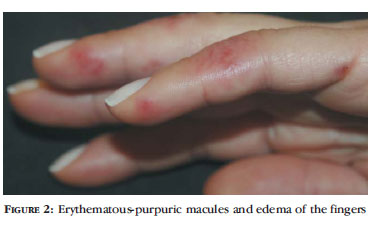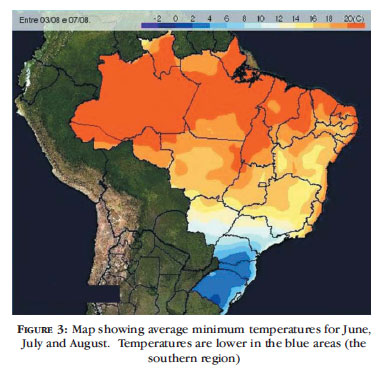Abstracts
Chilblains are an inflammatory skin condition that develops following exposure to the cold. They consist of pruritic and/or painful erythematous-to-violaceous acral lesions and are the result of an abnormal vascular response to exposure to the cold. This benign condition is common in southern Brazil, particularly in Rio Grande do Sul where climatic conditions, together with cultural and economic aspects, facilitate the development of these sores.
Chilblains; Erythema; Extreme cold; Frostbite
Eritema pérnio é uma condição inflamatória da pele que ocorre após exposição ao frio e se manifesta com lesões eritêmato-violáceas, pruriginosas e dolorosas nas extremidades. Ocorre devido a uma resposta vascular alterada à exposição ao frio. Esta condição benigna é frequente na região sul do Brasil, especialmente no Rio Grande do Sul, onde as características clínicas, associadas a aspectos culturais e econômicos, promovem o desenvolvimento do eritema pérnio.
Congelamento das extremidades; Eritema; Frio extremo; Pérnio
WHAT IS YOUR DIAGNOSIS?
Case for diagnosis* * This study was conducted at the Santa Casa de Misericórdia of Porto Alegre, Porto Alegre, Rio Grande do Sul, Brazil.
Caso para diagnóstico
Renata Elise TonoliI; Paulo Ricardo Martins SouzaII
IMedical Resident in Dermatology at Santa Casa de Misericórdia de Port Alegre, Rio Grande do Sul, Brazil
IIMaster's Degree in Medical Sciences awarded by the Health Sciences Federal University of Porto Alegre (UFCSPA). Preceptor, Department of Dermatology, Santa Casa de Misericórdia of Porto Alegre and Pontifical Catholic University of Rio Grande do Sul (PUC-RS), Porto Alegre, Rio Grande do Sul, Brazil
Mailing address Mailing address: Dr Paulo Ricardo Martins Souza Rua Professor Annes Dias, 295 - Centro. 90020-090 - Porto Alegre, RS, Brazil E-mail: paulo@e-consultas.com.br
ABSTRACT
Chilblains are an inflammatory skin condition that develops following exposure to the cold. They consist of pruritic and/or painful erythematous-to-violaceous acral lesions and are the result of an abnormal vascular response to exposure to the cold. This benign condition is common in southern Brazil, particularly in Rio Grande do Sul where climatic conditions, together with cultural and economic aspects, facilitate the development of these sores.
Keywords: Chilblains; Erythema; Extreme cold; Frostbite
RESUMO
Eritema pérnio é uma condição inflamatória da pele que ocorre após exposição ao frio e se manifesta com lesões eritêmato-violáceas, pruriginosas e dolorosas nas extremidades. Ocorre devido a uma resposta vascular alterada à exposição ao frio. Esta condição benigna é frequente na região sul do Brasil, especialmente no Rio Grande do Sul, onde as características clínicas, associadas a aspectos culturais e econômicos, promovem o desenvolvimento do eritema pérnio.
Palavras-chave: Congelamento das extremidades; Eritema; Frio extremo; Pérnio
CASE REPORT
A 30-year-old woman presented complaining of painful, pruritic lesions on her fingers that had been present for two weeks. The lesions worsened with exposure to the cold and improved when her hands were warmed. The patient denied trauma, changes in skin color, fever or arthralgia. She reported that she did not smoke and had had no previous diseases. Physical examination revealed erythematous, purpuric macules on her fingers (Figures 1 and 2). Her hands were cold to the touch, but there were no other significant changes in the skin.
DISCUSSION
Diagnosis of chilblains is essentially clinical. The condition consists of erythematous, edematous, sometimes purple, pruritic and/or painful lesions in areas exposed to the cold. Blistering may occur.1-7 It primarily affects the hands, feet, nose and ears.1-3 Chilblains are triggered by a combination of cold and humidity. The condition is more common in young women and is rare in children and in the elderly.5 Chilblains in the elderly may be a sign of systemic disease.1 The labor aspect, particularly working in the open air, favors the development of the condition.
Susceptible individuals may develop lesions due to alterations in their neurovascular response to temperature changes. Although there are no pathognomonic histologic substrates in chilblains, many studies have shown prominent perivascular inflammation and mononuclear cell infiltrate with edema of the papillary dermis.3
Chilblains improve within a few days unless exposure to the cold and damp persists.6 The main therapeutic measures are keeping the affected areas warm and avoiding re-exposure to the cold. Vasodilators, amlodipine or nifedipine are sometimes used. Prognosis with chilblains is excellent.3,4 Susceptible individuals should avoid injury, and take preventive measures to avoid exposure to the cold. Recognizing the clinical features of chilblains prevents delays in diagnosis and treatment.3 The sores develop between 12 and 24 hours after exposure to the cold and are characterized by erythematous, purple, edematous, single or multiple lesions accompanied by intense pain, itching or burning.
The principal differential diagnosis is Raynaud's phenomenon. Other diseases that can cause erythematous, recurrent, nodular and ulcerative lesions include erythema induratum, nodular vasculitis, erythema nodosum, cold panniculitis and thromboembolic events.4 Chilblain lesions are self-limiting and respond to warmth and vasodilator drugs, unlike vasculitis, which requires corticosteroids or immunosuppressive drugs.4,5
The southern region of Brazil, particularly Rio Grande do Sul has climatic features that, together with cultural and economic aspects (unheated environments, unheated water), facilitate the development of chilblains. The condition is common in both public and private outpatient dermatology clinics in this state, particularly between May and August (Figure 3).
Received on 09.08.2011.
Approved by the Advisory Board and accepted for publication on 04.10.2011.
Conflict of interest: None
Financial funding: None
- 1. Guadagni M, Nazzari G. Acute Perniosis in Elderly people: A predictive sign of systemic disease? Acta Derm Venereol. 2010;90:544-5.
- 2. Schwartz J, Souza PRM, Duquia RP. Alterações por dano térmico-frio. In: Ramose- Silva M, Castro MCR. Fundamentos de dermatologia. Rio de Janeiro: Atheneu; 2009. p.581-6.
- 3. Prakash S, Weisman MH. Idiophatic chilblains. Am J Med. 2009;122:1152-5.
- 4. Simon TD, Soep JB, Hollister JR. Pernio in Pediatrics. Pediatrics. 2005;116;e472-5.
- 5. Diniz JC, Rabelo Junior CN, Salum AME, Liphaus BL, Caleiro MTC, Silva CAA.Eritema pérnio na faixa etária pediátrica. Pediatria (São Paulo). 2009;31:297-302.
- 6. Spelling PF, Gruber C, Viecili SEM, Miyoshi M, Marcovici FP, Zanoni A. Perniose: perfil clínico de uma casuística atendida em ambulatório de reumatologia pediátrica. Pediatria (São Paulo). 2001;23:154-8.
- 7. Filho R. Perniose na lepra. An Bras Dermatol Sifilogr. 1934;9:49-53.
Publication Dates
-
Publication in this collection
10 Aug 2012 -
Date of issue
Aug 2012
History
-
Received
09 Aug 2011 -
Accepted
04 Oct 2011




